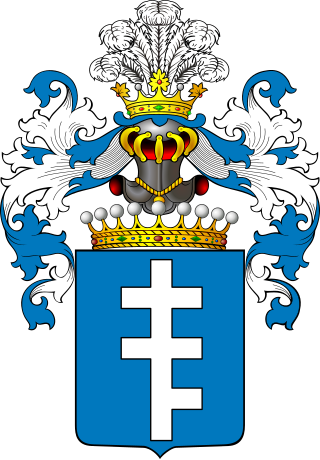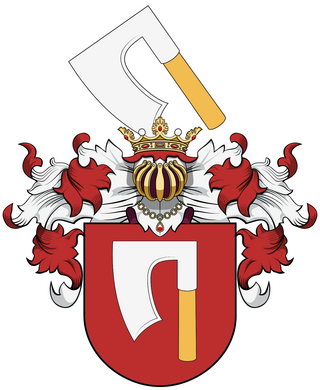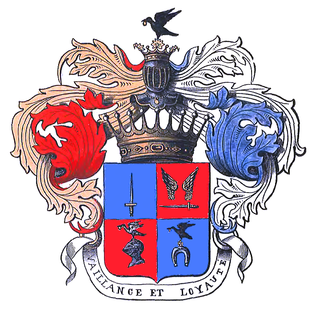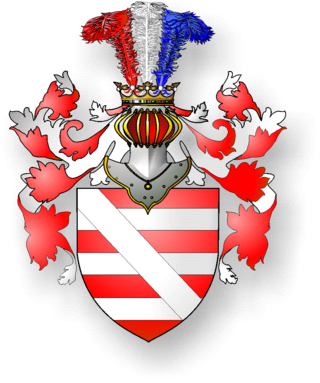Related Research Articles

James Louis Henry Sobieski was a Polish-French nobleman, politician, diplomat, scholar, traveller and the son of John III of Poland by his wife Marie de La Grange d'Arquien.

The Dorpat Voivodeship was a unit of administrative division and local government in the Duchy of Livonia, part of the Polish–Lithuanian Commonwealth, from 1598 until the Swedish conquest of Livonia in the 1620s. The seat of the voivode was in the town of Dorpat (Tartu), while the regional assembly (sejmik) for the whole province of Livonia was located in Wenden. The area of the Dorpat Voivodeship was app. 9,000 square kilometers, and it had two senators in the Senate of the Polish–Lithuanian Commonwealth.
Stanisław Poniatowski was a Polish military commander, diplomat, and noble. Throughout his career, Poniatowski served in various military offices, and was a general in both the Swedish and Polish–Lithuanian militaries. He also held numerous civil positions, including those of podstoli of Lithuania and Grand Treasurer of the Lithuanian army in 1722, voivode of the Masovian Voivodeship in 1731, regimentarz of the Crown Army in 1728, and castellan of Kraków in 1752. Throughout his lifetime, he served in many starost positions.

The Brześć Kujawski Voivodeship was a unit of administrative division and local government in the Kingdom of Poland, from the 14th century to the Second Partition of Poland in 1793. It was part of the historic Kujawy region and the Greater Polish prowincja. Originally, its name was Brzesc Voivodeship, but after the 1569 Union of Lublin, it was renamed into Brzesc Kujawski Voivodeship, to distinguish it from Lithuanian Brest Litovsk Voivodeship.

Brest Litovsk Voivodeship was a unit of administrative territorial division and a seat of local government (voivode) within the Grand Duchy of Lithuania since 1566 until the May Constitution in 1791, and from 1791 to 1795 as a voivodeship in Poland. It was constituted from Brest-Litovsk and Pinsk counties.

The Inflanty Voivodeship, or Livonian Voivodeship, also known as Polish Livonia, was an administrative division and local government in the Polish–Lithuanian Commonwealth, since it was formed in the 1620s out of the Wenden Voivodeship and lasted until the First Partition of Poland in 1772. The Inflanty Voivodeship was one of the few territories of the Polish–Lithuanian Commonwealth to be ruled jointly by Poland and Lithuania.

The House of Zamoyski is the name of an important Polish noble (szlachta) family, which used the Jelita coat of arms. It is the Polish term for "de Zamość", the name they originally held as lords of Zamość. The family was influential in Polish politics for several centuries, and its members held various official titles, including those of Count and Countess.

The House of Potocki was a prominent Polish noble family in the Kingdom of Poland and magnates of the Polish–Lithuanian Commonwealth. The Potocki family is one of the wealthiest and most powerful aristocratic families in Poland.

The House of Sapieha is a Polish-Lithuanian noble and magnate family of Lithuanian and Ruthenian origin, descending from the medieval boyars of Smolensk and Polotsk. The family acquired great influence and wealth in the Polish–Lithuanian Commonwealth during the 16th century.

The House of Pac or Pacowie was one of the most influential noble families in the Grand Duchy of Lithuania during the era of the Polish–Lithuanian Commonwealth. Numerous high-ranking officials of the Commonwealth came from their ranks. Their coat of arms was Gozdawa.
Konstanty may refer to:

The House of Tęczyński was a powerful family of nobility (szlachta) in the Kingdom of Poland, during the times of the late Piast dynasty, the Jagiellon dynasty and in the early decades of the Polish–Lithuanian Commonwealth. They were an important family from Lesser Poland (Małopolska), active in Polish politics of their time.

Zborowski of the Jastrzębiec coat of arms was a Polish noble family from Greater Poland, It played a significant role in Polish politics in the 16th century.
Justynian Szczytt was a member of the Permanent Council, member of the parliament of the Polish–Lithuanian Commonwealth.

Krāslava New Palace or Plater's Palace is located in the historical region of Latgale, in eastern Latvia. It is an 18th-century manor ensemble with main manor house and other manor buildings and a Baroque-style park.

The House of Krasiński is the surname of a Polish noble family. Krasińska is the feminine form. The name derives from the village of Krasne in Masovia. The family dates from the 14th century. Its members were landowners and politically active in Masovia, Lithuania and Halychyna. The Krasiński family has produced officers, politicians and bishops. One of the most renowned members of the Krasiński family is the 19th-century poet, Zygmunt Krasiński, one of Poland's Three Bards.

The House of Mniszech was a Polish magnate and noble family bearing the Mniszech Coat of Arms.
Events in the year 2022 in Poland.

The Plater family is a German and Polish noble family originating from Westphalia, whose members first settled in Livonia and later in Lithuania and Poland.
References
- 1 2 Minakowski, Marek. "Jan Ludwik Plater z Broelu". wielcy.pl.
- 1 2 3 4 5 6 Link-Lenczowski, Andrzej. "Jan Ludwik Plater". www.ipsb.nina.gov.pl (in Polish). Retrieved 2023-11-29.